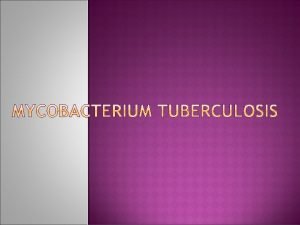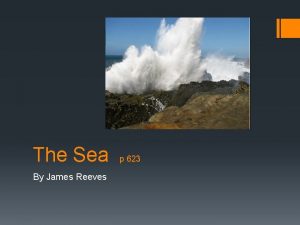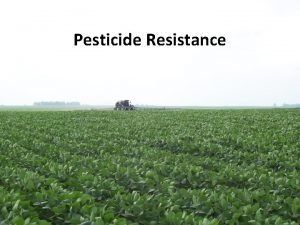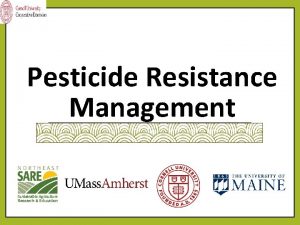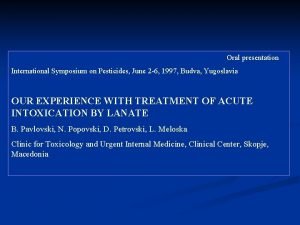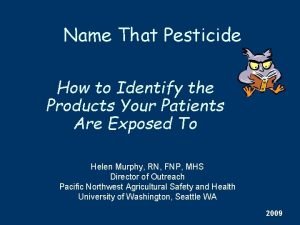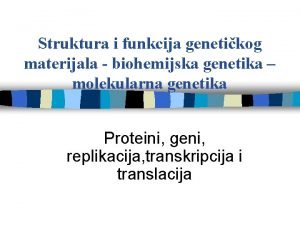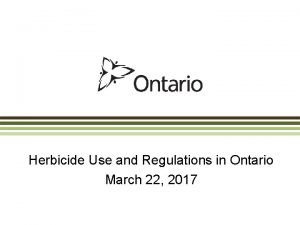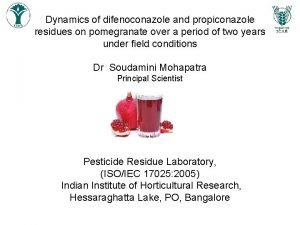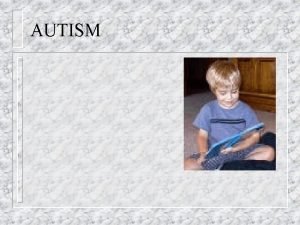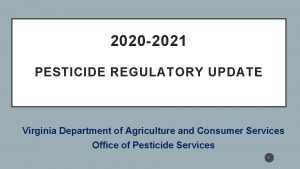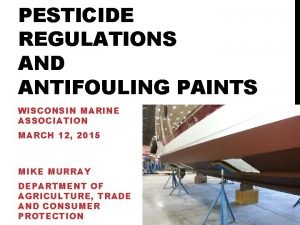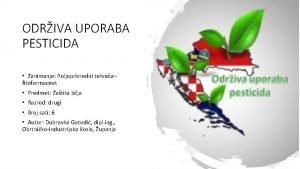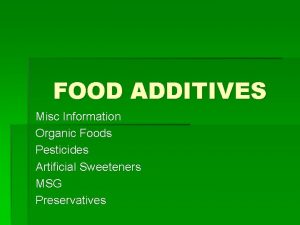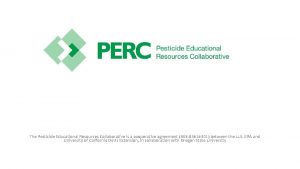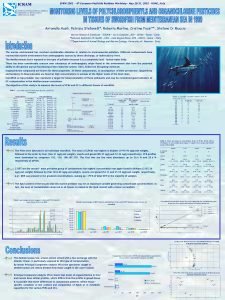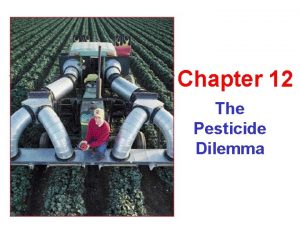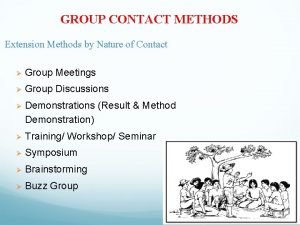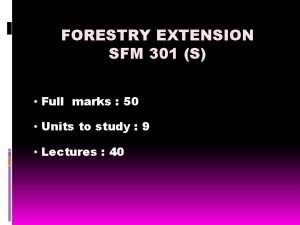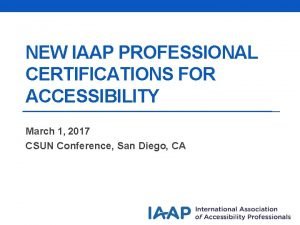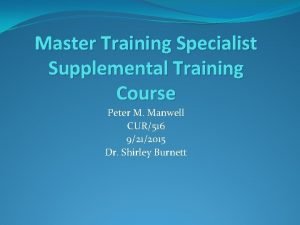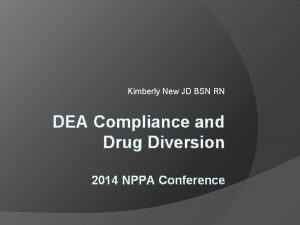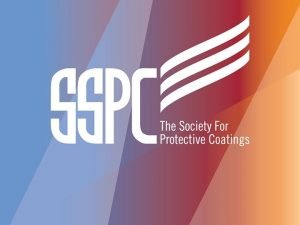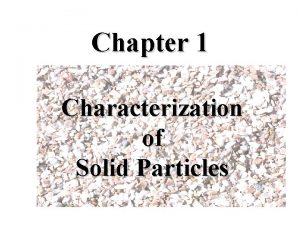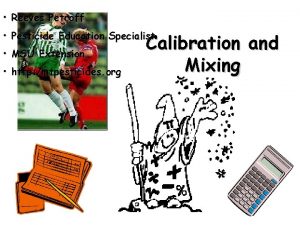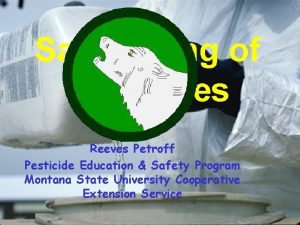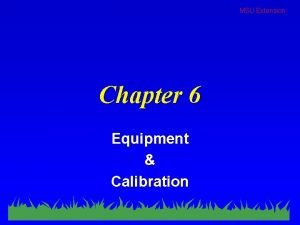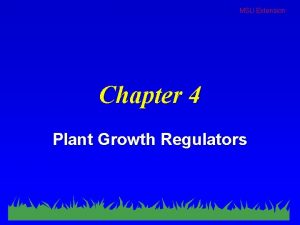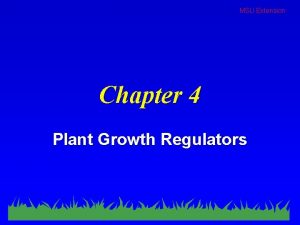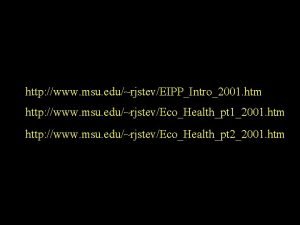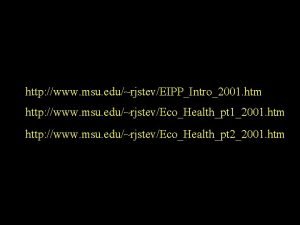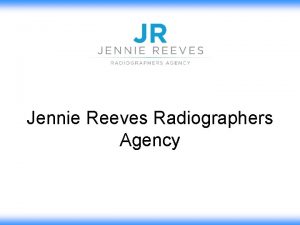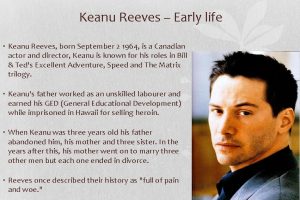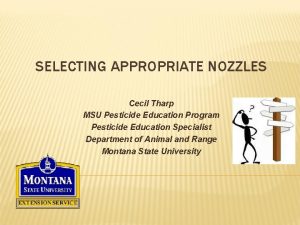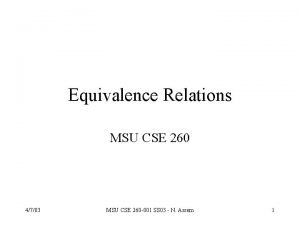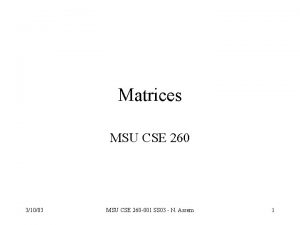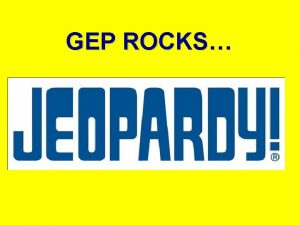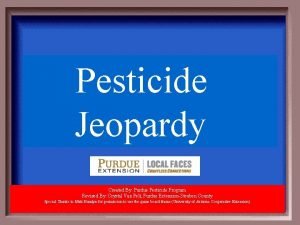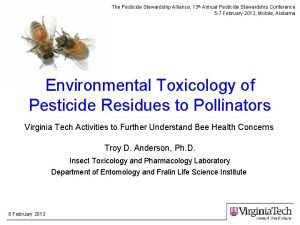Reeves Petroff MSU Extension Pesticide Education Specialist http















































- Slides: 47

Reeves Petroff MSU Extension Pesticide Education Specialist http: //mtpesticides. org Knowledge, Information & Links


How water quality affects certain pesticides • Minerals • p. H • Dirty Water Goal

How water quality affects certain pesticides Goal • Weak acid herbicides • Insecticides – Organophosphates – Carbamates

+ H O + H -+ O - H - Covalent Bonds – shared electrons p. H of 7 = neutral -Universal Solvent – Dissolves & attracts many substances

Hydrological Cycle Adds minerals and p. H to water CO 2 + H 20 = carbonic acid Carbonate CO 3 Alkaline Bicarbonate HCO 3 Alkaline Minerals

Water Primary diluent New Term Why water quality is important! • 1 pint or 1 quart per acre • 30 GPA application volume • 99% and 93% of spray solution

Minerals Hard Water

Total Dissolved Solids ppm grains * 17 ppm per grain TDS

Common mineral elements in Montana water Ions - Charged atoms Positive Charge (cations) Negative Charge (anions) Calcium (Ca++) Sulphate (SO 4 -) Magnesium (Mg++) Chloride (Cl -) Sodium (Na+) Bicarbonate (HCO 3 -) nitrate (NO 3 -) potassium (K+) iron (Fe++, Fe+++),

What is hard water? ppm/Gal Grains/Gal Soft 0 - 60 0 – 3. 5 Mod. Hard 60 - 120 3. 5 – 7. 0 Hard 120 - 180 7. 0 – 10. 5 Very Hard Over 180 Over 10. 5 Reference: Montana Environmental Health Association – Sanitarian’s Field Guide

How is TDS measured? Calcium = 666 ppm Sulphate = 2434 ppm Magnesium = 234 ppm Chloride = 32 ppm Sodium = 130 ppm Bicarbonate = 346 ppm 3842 ppm. • Weight • EC • Chemical reaction (Test Strips) TDS > 500 mg/L (ppm) is salty to taste

Types Of Water Drinking water <500 TDS (EPA) Fresh Water : <1, 000 TDS Brackish : 1, 000 -5, 000 TDS Highly Brackish : 5, 000 -15, 000 TDS Saline : 15, 000 -30, 000 TDS Sea Water : 30, 000 -40, 000 TDS Brine : 40, 000 -300, 000+ TDS



Understanding Water Hardness Water Softening – Ion Exchange Na+ Na+ Na+ • Resin Beads • anionic (-) • hold cations(+)

Mg++ Ca++ Ca++ Na+ Mg++ Na+ Na+ Flow Na+ Mg++ Ca++ Na+ Mg++ Na+ Ca++ Na+ Na+ Na+

Water Quality Effects on Herbicides Hard Water Maximum Water Hardness Glyphosate (Roundup) use rate Grains/US gal. ppm Ca. C 03 equivalent Low Rates for Annual Grass Weeds 20 350 Higher rates for Perennial Weeds 40 700

Weak Acid Herbicides • Most affected by hard water and p. H • Acids release H+ ions in water • Weak acids release H+ slightly Glyphosate – Roundup Paraquat – Gramoxone Clethodim – Select Sethoxydim – Poast Many 2, 4 -D products

Weak Acid Herbicides C C-O - C-CH 3 C CH 3 | +NH 2 | CH 3 Dissociation – splitting of the molecule

Weak Acid Herbicides C CH 3 | - 3 O CH CC- +Ca + C C C-O - C-CH 3 C +NH 2 | CH 3

- Herbicide molecule • Penetrate the target weed intact • Travel to the site of action • Kill the plant.

CH 3 | C C-O -+NH 2 | C-CH 3 C Intact molecule = more plant penetration

Water p. H & Herbicides What is p. H? • Measures H+ ions • potential Hydrogen • More H+ = lower p. H = more acid

Logarithmic

p. H and Herbicides • Acidic conditions for most herbicides – p. H 3 to 6 • Lower p. H avoids dissociation • The exceptions • Ally • Escort • Read the label

p. H Hard Water High p. H = dissociation Molecule is vulnerable C C-O - +Ca+ C-CH 3 C CH 3 | +NH 2 | CH 3

Bicarbonate Waters • Associated with sodium • > 500 ppm & high p. H • Affects 2, 4 -D • Affects “dim” herbicides • Poast - sethoxydim • Select – clethodim • Achieve -tralkoxydim

…dim herbicides


Bicarbonate Waters - Solution • Use maximum allowed rate • Apply during optimal growth stage • Adjuvants - Non-ionic Surfactant (NIS) - Acidifiers/buffers

Water Quality Effects on Herbicides • diquat (Reglone, Reward) • paraquat (Gramoxone) • glyphosate (Roundup, Touchdown, etc. Organic Matter OM Turbidity Dirt Total Suspended Solids TSS

Water Quality Effects on Herbicides • Binds the herbicide + Herbicide not + Roundup + - OM absorbed + - • Clogs screens • Pumps?

TSS – Solutions • Clean water supply • Filtering Settle basin Filters

p. H & Insecticides • Organophosphates – Malathion – Parathion • Carbamates – Sevin


Solutions? 1. Test the water • Test strips • Meters • Labs

Test strips • Easy to use • Cheap - $8 to $20 • Some combine ph & hardness • Improved accuracy

Meters • Accurate p. H, EC, TDS $179. 00 • Calibrated • $100 + www. gemplers. com

Labs • Collection guidance • Tests performed • How to interpret results • $50 – $100+ http: //mtpesticides. org Links Labs

1. Test the water 2. Reduce Water Volume • Less ions present • Example: 25 to 15 GPA • Only if practical • p. H still a problem • Label?

1. Test the water 2. Reduce Water Volume 3. Use maximum allowed rate • More pesticide ions present • More costly • Non-target damage?

1. Test the water 2. Reduce Water Volume 3. Use maximum allowed rate 4. Spray ASAP after mixing • Mix what you need • Smaller areas • Planning • Scouting • Good notes

1. Test the water 2. Reduce Water Volume 3. Use maximum allowed rate 4. Spray ASAP after mixing 5. Adjuvants

Adjuvants • Additives to improve performance • Acidifiers • Buffers p. H • Conditioners • Ammonium Sulfate (AS) • Non-ionic surfactants (NIS) Hard Water www. herbicide-adjuvants. com


 Generation time
Generation time Petroff method
Petroff method Extension education is non formal education
Extension education is non formal education Line extension vs brand extension
Line extension vs brand extension The sea poem by james reeves analysis
The sea poem by james reeves analysis Define pesticide resistance
Define pesticide resistance Xxxxxxxxxx xxxxxxxxx
Xxxxxxxxxx xxxxxxxxx Lanate pesticide
Lanate pesticide Pesticide classification chart
Pesticide classification chart Slowly the tide creeps up the sand
Slowly the tide creeps up the sand Jennie reeves
Jennie reeves Dr douglas reeves
Dr douglas reeves Keanu reeves matrix
Keanu reeves matrix Ontario pesticide regulations
Ontario pesticide regulations Agriculture pesticide difenoconazole
Agriculture pesticide difenoconazole Keanu reeves
Keanu reeves Virginia pesticide registration
Virginia pesticide registration Kenney reeves
Kenney reeves Wisconsin pesticide applicator license
Wisconsin pesticide applicator license Tablica miješanja pesticida
Tablica miješanja pesticida Miss reeves
Miss reeves Msg pesticide
Msg pesticide Dr andrew reeves
Dr andrew reeves Pesticide educational resources collaborative
Pesticide educational resources collaborative European pesticide residue workshop
European pesticide residue workshop Pesticide treadmill definition
Pesticide treadmill definition Philosophy of extension education
Philosophy of extension education Demonstration method
Demonstration method Extension education is an art
Extension education is an art Principle of extension
Principle of extension Http //mbs.meb.gov.tr/ http //www.alantercihleri.com
Http //mbs.meb.gov.tr/ http //www.alantercihleri.com Http //pelatihan tik.ung.ac.id
Http //pelatihan tik.ung.ac.id Non specialist audience
Non specialist audience Specialist formula sheet year 12
Specialist formula sheet year 12 Punto rojo overlay
Punto rojo overlay Prm specialist
Prm specialist Certified professional in web accessibility
Certified professional in web accessibility Do microsoft office specialist certifications expire
Do microsoft office specialist certifications expire Master training specialist certification
Master training specialist certification Dea compliance specialist
Dea compliance specialist Coating application specialist
Coating application specialist Always has a narrow niche
Always has a narrow niche Specialist species
Specialist species Characterization of solid particles
Characterization of solid particles Specialist creed
Specialist creed Offender workforce development specialist
Offender workforce development specialist Brandt wagner
Brandt wagner Specialist species
Specialist species

